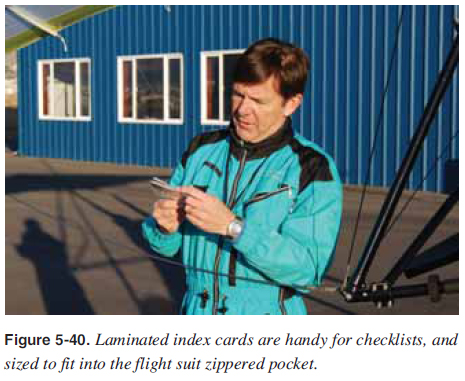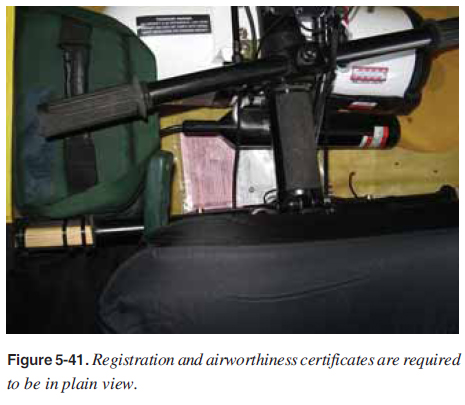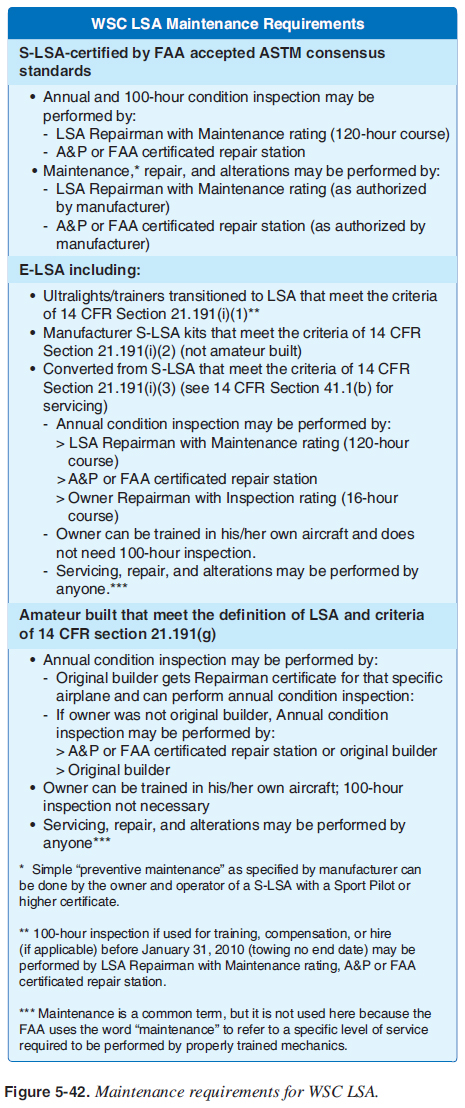
 |
|
||
| CHAPTER 5. Prefl ight and Ground Operations
Prefl ight Inspection Each aircraft must have a routine prefl ight inspection before fl ight. Use a written checklist during prefl ight and ground operations to maintain an established procedure. [Figure 5-40] A written checklist is required so nothing is forgotten. Ground checklists include prefl ight preparation, prefl ight inspection, occupant prefl ight brief, fl ight deck management, startup, taxi, before takeoff, and aircraft shutdown. Be smart and follow the regulations—use a written checklist. All checklists should be secured so they do not fl y out of the fl ight deck in fl ight and hit the propeller. Securing with zippered pockets and having lanyards for the checklists is recommended. Manufacturers of Special Light-Sport Aircraft (S-LSA) have checklists that come with the aircraft. Pilots with an experimental aircraft may need to develop their own.  Certifi cates and Documents The fi rst step of prefl ight inspection is to ensure the aircraft is legally airworthy which is determined in part, by the following certifi cates and documents:
ARROW is the acronym commonly used to remember these items. The PIC is responsible for making sure the proper documentation is on board the aircraft when operated. [Figure 5-41]  Aircraft logbooks are not required to be on board when it is operated. However, inspect the aircraft logbooks prior to fl ight to confi rm the WSC aircraft has had all required inspections. The owner/operator must keep maintenance records for the airframe and powerplant. At a minimum, there must be an annual condition inspection within the preceding 12 calendar months. In addition, the WSC aircraft may also need a 100-hour inspection in accordance with 14 CFR part 91 if it is used for hire (e.g., for training operations). [Figure 5-42] If a transponder system is used, the transponder must be inspected within each preceding 24 calendar months.  The pilot must have in his or her possession a Sport pilot certifi cate for the aircraft being fl own, medical eligibility, and a government issued photo identifi cation. For a Sport Pilot Certifi cate, medical eligibility can be a valid United States driver’s license, which also serves as government issued photo identifi cation. To fl y the aircraft with Private Pilot privileges, the pilot needs a valid FAA minimum third class medical certifi cate accompanied by a government issued photo identifi cation and Private Pilot certifi cate for WSC aircraft. See Chapter 1, Introduction to Weight-Shift Control, for details on specifi c pilot certifi cates and privileges. |
| ©AvStop Online Magazine Contact Us Return To Books |